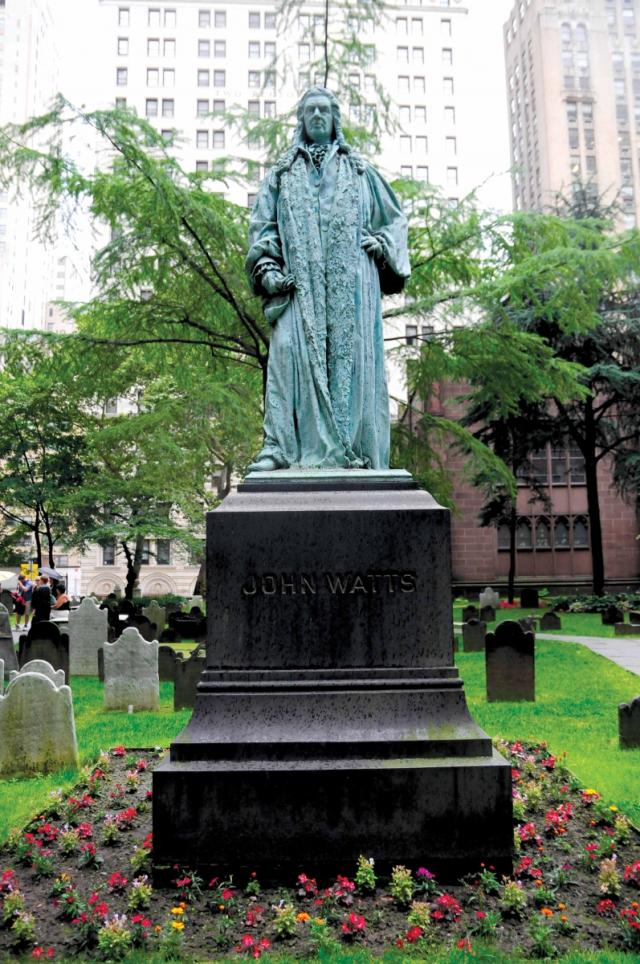Who Was John Watts Jr.?
He stands imposingly in the south side of Trinity churchyard, a fifteen-foot-high bronze sculpture of an eighteenth century English barrister gone green with age. Passing tourists are likely to recognize the neighboring tombs of Alexander Hamilton and Robert Fulton, and wonder, “Who is that?”
His name is John Watts Jr., born 1749. He died in 1836. The statue was erected in 1893 by John Watts DePeyster, Watts’ grandson, as an attempt to keep his grandfather’s memory alive for the people of Manhattan. It is a physical monument to the man in the city he helped shape.
Watts was one of seven children of John Watts Sr., a Scottish immigrant from a wealthy background, and Anne DeLancey of the colony’s founding DeLancey family. He was likely born at his father’s country house at Rose Hill, an estate that stretched from 21st Street to 30th Street, and from Broadway to the East River. Or perhaps he was born in his father’s town home in Lower Manhattan. In either case, he was a New Yorker from birth.
Young Watts was a child of privilege. His maternal uncles served in high government posts, and his father was a prosperous merchant who dealt in, among other things, pickled peppers. Watts Sr. also held several posts in the colonial government, serving as a member of the Colonial Assembly and the King’s Council in the years just before the Revolution.
Watts Jr. graduated with his A.M. from King’s College in May, 1769. At just 19, Watts gave the “valedictory oration” at commencement ceremonies inside the first Trinity Church. A few years later, he was appointed Royal Recorder of New York, a colonial post that included serving as a mayoral assistant, judge, and in sundry administrative and judicial functions. Watts Jr. would be New York’s last Royal Recorder.
In 1775, Watts Sr., who was a Loyalist and government official, became the target of a threatening open letter from a group of patriots. He fled the colonies for England. In 1779, the New York State Legislature “attainted [Watts Sr.] with treason,” seized Rose Hill and the Lower Manhattan townhouse, banished Watts Sr, and, theoretically, “tainted the blood” of Watts’ descendants with treason.
In 1784, Watts Jr. and his brother Robert were denied a petition to have the attainder against their family overturned, though they were allowed to purchase back their father’s properties. Sources suggest that Watts Jr. was a patriot: he was the only Crown official in New York who held elected state or federal office after the Revolution.
Shortly after his father fled the colonies, Watts Jr. married Jane DeLancey in a double wedding with her sister Susanna. Some sources suggest DeLancey was Watts Jr.’s cousin. The couple went on to have eleven children, eventually making a home at Rose Hill.
Watts Jr.’s career flourished. In 1791, he was elected to the New York State Assembly , where he served as speaker. In 1793, he was elected to the United States Congress. He served during the fifth and sixth years of Washington’s presidency but was defeated in his bid for reelection. In 1806, he was appointed the first judge in Westchester County.
Additionally, the Watts family was active in Trinity Church.
Throughout his life Watts experienced considerable tragedy. As John Watts DePeyster, his grandson and commissioner of the monument wrote, “Mr. Watts was a monument of affliction, in that he had seen his wife, six handsome, gifted, and gallant sons, and four daughters precede him to the grave. One childless daughter survived him and three grandchildren.”
Two of these untimely deaths would leave another, lasting legacy. In 1793, the only child of his younger sister, Margaret Watts Leake, died at the age of eight. The boy was the favorite and planned heir of his childless paternal uncle, John George Leake. John George Leake and Watts Jr. were friends, and at some point it was decided that Watts’ son Robert would be Leake’s heir, provided the young man took the surname Leake. Leake died. Robert took the name.
Robert J. Watts Leake, inherited the fortune, and promptly passed away, leaving no wife or children. Watts Jr. inherited Leake’s fortune from his own son.
Watts was already a wealthy man, living in Lower Manhattan with his two grandsons, the future General Philip Kearny and DePeyster. He decided to use the inheritance to found and endow the Leake and Watts Orphan Home, to “foster, educate, and protect orphans.” According to DePeyster, this was an idea Leake and Watts had discussed. The home was one of the country’s first private charitable institutions dedicated to child welfare.
The Leake and Watts Orphan House was founded in 1831. In 1843, it opened at the Cathedral of St. John the Divine, and in 1890 it was moved again, this time from Manhattan to a site in Yonkers. This final move prompted DePeyster to commission the monument for Trinity churchyard.
Today, Leake and Watts Services, Inc. operates across the New York metro area and serves 5,000 children a year, providing everything from foster care to preschool services for autistic children.
Tags:






